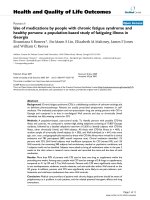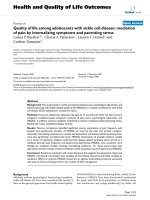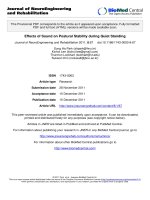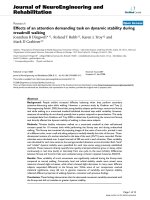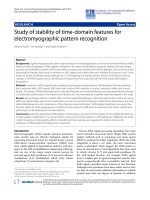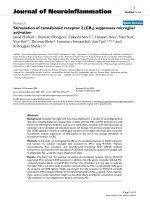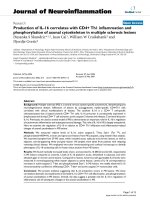Báo cáo hoa học: " Stability of neutral-type descriptor systems with multiple time-varying delays" pptx
Bạn đang xem bản rút gọn của tài liệu. Xem và tải ngay bản đầy đủ của tài liệu tại đây (228.05 KB, 14 trang )
Advances in Difference
Equations
This Provisional PDF corresponds to the article as it appeared upon acceptance. Fully formatted
PDF and full text (HTML) versions will be made available soon.
Stability of neutral-type descriptor systems with multiple time-varying delays
Advances in Difference Equations 2012, 2012:15
doi:10.1186/1687-1847-2012-15
Yuxia Zhao ()
Yuechao Ma ()
ISSN
Article type
1687-1847
Research
Submission date
3 October 2011
Acceptance date
16 February 2012
Publication date
16 February 2012
Article URL
/>
This peer-reviewed article was published immediately upon acceptance. It can be downloaded,
printed and distributed freely for any purposes (see copyright notice below).
For information about publishing your research in Advances in Difference Equations go to
/>For information about other SpringerOpen publications go to
© 2012 Zhao and Ma ; licensee Springer.
This is an open access article distributed under the terms of the Creative Commons Attribution License ( />which permits unrestricted use, distribution, and reproduction in any medium, provided the original work is properly cited.
Stability of neutral-type descriptor systems with
multiple time-varying delays
Yuxia Zhao∗ and Yuechao Ma
College of Science, Yanshan University, Qinhuangdao Hebei 066004, P. R. China
∗ Corresponding
author:
Email address:
YM:
Abstract
This article deals with the problem of stability of descriptor neutral systems with multiple
delays. Using Lyapunov functional and free-weighting matrix method, a delay-dependent
stability criterion is obtained and formulated in the form of linear matrix inequalities,
which can easily be checked by utilizing Matlab linear matrix inequality toolbox. Finally,
a numerical example is presented to illustrate the effectiveness of the method.
Keywords: neutral-type descriptor systems; asymptotical stability; free-weighting matrix;
linear matrix inequality.
1. Introduction
Since the time delay is frequently viewed as a source of instability and encountered in various engineering systems such as chemical processes, long transmission lines in pneumatic systems, networked
control systems, etc., the study of delay systems has received much attention and various topics have
been discussed over the past years. Commonly, the existing results can be classified into two types: delayindependent conditions and delay-dependent conditions. In general, the delay-dependent case is more
conservative than delay-independent case.
A neutral system with time-delays which contains delays both in its state and in its derivatives of state
is encountered in many dynamic systems and their presences must be taken into account in real dynamic
process such as circuit systems, population dynamics, automatic control, and heat exchangers, etc. Due
to its profound and practical background, much attention has been focused on the problems of stability
analysis for neutral time-delay system from mathematics and control communities [1, 2, 3, 4, 5, 6, 7]. Using
Lyapunov method, Park [1] presented new sufficient conditions for the stability of the systems in terms of
linear matrix inequality (LMI) which can be easily solved by various convex optimization algorithms. Some
delay-independent stability criteria were given in terms of the characteristic equation of system, involving
the measures, eigenvalues, spectral radius, and spectral norms of the corresponding matrices [3]. Although
the conditions are easy to check, they require the matrix measure to be Hurwitz matrix. The problem
of delay-dependent stability criteria for a class of constant time-delay neutral systems with time-varying
structured uncertainties was investigated [4]. Han [5] obtained delay-dependent stability conditions for
uncertain neutral time-varying system by model transformation method, due to cross terms of model
transformation, results are less conservative. Zhao [6] dealt with the problem of delay-dependent robust
stability for delay neutral type control system with time-varying structured uncertainties and time-varying
delay. Some new delay and its derivative-dependent criteria were derived. He [7] concerned the problem
of the delay-dependent robust stability of neutral systems with mixed delays and time-varying structured
uncertainties. A new method based on linear matrix inequalities was presented that makes it easy to
2
calculate both the upper stability bounds on the delays and the free weighting matrices. Since the criteria
take the sizes of the neutral- and discrete-delays into account, it is less conservative than previous methods.
Recently, Li [8] studied the stability of the neutral-type descriptor system with mixed delays, and derived some stability criteria, but the criteria are all delay independent which do not include the information
on delay, therefore have a some conservative in. However, the descriptor delay neutral system stability and
control have not yet fully investigated, and their stability conditions are not given a strict linear matrix
inequalities, it is difficult to achieve through the LMI toolbox in Matlab. Particularly delay-dependent
sufficient conditions are few even non-existing in the published works.
In this article, the problem of stability of neutral type descriptor systems with time-varying delays is researched. Using free-weight matrix method in combination with Lyapunov–Krasovskii functional method
is used to obtain the LMI-based delay-dependent sufficient conditions for stability. And we consider parameter uncertainties both in its state and in the derivatives of its state. Examples are given to illustrate
the effectiveness of the condition.
Notations: The notation in this article is quite standard. Rn and Rn×m denote, respectively the ndimensional Euclidean space and the set of all n × m real matrices. The superscript X T and X −1 denote,
respectively, the transpose and the inverse of any square matrix X. I is the identity matrix of appropriate
dimension. · will refer to the Euclidean vector norm. The symbol ∗ always denotes the symmetric block
in one symmetric matrix.
2. System description
Consider the following uncertain neutral type descriptor time-delay systems:
m
m
E x(t) −
˙
(Di + ∆Di )x(t − hi (t)) = (A0 + ∆A0 )x(t) +
˙
(Ai + ∆Ai )x(t − di (t))
i=1
i=1
x(t) = ϕ(t),
t ∈ [−max{h, d}, 0]
3
(1)
where x(t) ∈ Rn is the state, ϕ(t) is a continuous vector-valued initial function, 0 < h1 (t) < h2 (t) <
˙
˙
· · · < hm (t) ≤ h, 0 = d0 (t) < d1 (t) < · · · < dm (t) ≤ d, 0 < hi (t) < τi ≤ τ ≤ 1, 0 < di (t) < µi ≤ µ ≤ 1,
A0 , Ai , Di ∈ Rn , Ai ,Di are known constant matrices with appropriate dimensions. Where ∆Ai , ∆Di are
the constant matrices which denote time-varying parameter uncertainties and are assumed to belong to
certain bounded compact sets. The parameter uncertainties are assumed to be of the following form:
∆A0 (t) ∆Ai (t) ∆Di (t)
= HF (t)
E0 Ei1 Ei2
(2)
where H, Eik (k = 1, 2) are known real constant matrices with appropriate dimensions, and F (t) is the
uncertain matrix satisfying F T (t)F (t) ≤ I, ∀t, I is unit matrix with appropriate dimensions.
Remark 1. When E = I, the system (1) reduces to the traditional uncertain neutral system with
time-varying delays.
Remark 2. Li [8] considered the stability of neutral type descriptor systems with constant time-delay,
and the system did not include parameter uncertainty in the derivative of its state. So the system (1) is
more widely in our article.
S11 S12
T
T
, with S11 = S11 , S12 = S12 , then the
Lemma 1 (Schur-complement) For any matrix S =
T
S12 S22
following conditions are equivalent:
(1)S < 0,
(2)S11 < 0,
T −1
S22 − S12 S11 S12 < 0,
(3)S22 < 0,
−1 T
S11 − S12 S22 S12 < 0
P1 + X Q1
P2 + X Q2
> 0,
> 0, if and only if
Lemma 2 [9] If there is symmetric matrix X,
T
T
Q1
R1
Q2
R2
P1 + P2 Q1 Q2
QT R1 0 > 0
1
QT
0 R2
2
Lemma 3 [10] Given matrices Q = QT , H, E with appropriate dimensions, we have
4
Q + HF E + E T F T H T < 0,
for all F (t) satisfying F T F ≤ I if and only if there exists a constant ε > 0, such that
Q + εHH T + ε−1 E T E < 0.
3. Main results
Theorem 1 The nominal system of the system (1) is asymptotically stable, if there exist nonsingular
symmetric matrix P , and positive-definite symmetric matrices Qi , Si , Ri and any appropriate dimensional
matrices Ni0 , Nij , Mij (i, j = 1, 2, . . . , m), such that the following LMI holds:
ETP = P TE ≥ 0
(3a)
¯
¯
¯
Ω ΓT S ΓT R −N
∗ −S 0
0
<0
∗ ∗ −R 0
∗ ∗
∗ −R
(3b)
where
Ω00
.
.
.
·
Ω=
·
.
.
.
∗
· · · Ω0m
..
.
.
.
.
Ω0m+1
···
.
.
.
..
.
· · · Ωmm Ωmm+1 · · ·
···
∗
Ωm+1m+1 · · ·
..
.
.
.
.
.
.
.
..
···
∗
∗
···
.
Ni0
.
.
.
.
.
.
Nim
Ωm2m+1
¯
, Ni =
Mi1
Ωm+12m+1
.
.
.
.
.
.
Ω2m+12m+1
Mim
Ω02m+1
¯
¯
S = S S ... S ,R = d R d R ... d R ,Γ = A A ... A D ... D ,
1
2
m
1 1 2 2
m m
0
1
m
1
m
5
¯
N = d N d N . . . d N , S = diag{S1 , S2 , . . . , Sm }, R = diag{d1 R1 , d2 R2 , . . . , dm Rm },
¯
¯
¯
1 1 2 2
m m
m
m
Ω00 = P T A0 + AT P +
0
T
Ni0 E + E T Ni0 +
i=0
m
T
E T Nik ,
Qi , Ω0k = P Ak − Nk0 E +
i=1
i=0
m
T
T
E T Mik , Ωkk = −(1 − µi )Qk − Nkk E + E T Nkk ,
Ω0m+k = PDk +
k = 1, 2, . . . , m,
i=0
T
T
Ωlm+k = −E T Mlk , l, k = 1, 2, . . . , m, Ωlk = −Nkl E − E T Nlk ,
Ωm+km+k = −(1 − τi )E T Sk E,
l = 1, 2, . . . , m,
l < k ≤ m,
k = 1, 2, . . . , m,
Proof: Constructing a Lyapunov–Krasovskii functional as follows:
V (x, t) = V1 + V2 + V3 + V4
(4)
in which
t
m
V1 = xT (t)E T P x(t), V2 =
xT (s)Qi x(s)ds,
i=0
t−di (t)
t
m
0
m
T
t
T
xT (s)E T Ri E x(s)dsdθ,
˙
˙
x (s)E Si E x(s)ds, V4 =
˙
˙
V3 =
i=0
i=0
t−hi (t)
−di (t) t+θ
The time derivative of V (x, t) along the trajectory of system (1) is given by
˙
˙
˙
˙
˙
V = V 1 + V2 + V 3 + V 4
m
˙
V1 = 2xT (t)PEx(t) = 2xT (t)P
˙
m
Ai x(t − di (t)) +
A0 x(t) +
i=0
m
˙
V2 =
Di x(t − hi (t))
˙
i=0
m
xT (t)Qi x(t) −
(1 − µi )xT (t − di (t))Qi x(t − di (t)),
i=1
m
i=1
m
˙
V3 =
(5)
xT (t)E T Si E x(t) −
˙
˙
i=1
(1 − τi )xT (t − hi (t))E T Si E x(t − hi (t))
˙
˙
i=1
m
˙
V4 =
m
T
t
T
xT (s)E T Ri E x(s)ds
˙
˙
di x (t)E Ri E x(t) −
˙
˙
i=1
i=1
t−di (t)
According to Newton–Leibniz formula, apparently for any appropriate dimensional matrices Ni0 , Nij ,
Mij (i, j = 1, 2, . . . , m), then
m
m
xT (t)Ni0 +
2
i=0
m
xT (t − di (t))Nij +
j=1
xT (t − hj (t))Mij Ex(t) − Ex(t − di (t)) −
˙
j=1
t
E x(s)ds = 0,
˙
t−di (t)
(6)
6
As for any appropriate dimensional matrix Xi ≥ 0, (i = 1, 2, . . . , m), then
t
m
T
ξ1 (t)Xi ξ1 (t)ds = 0,
T
ξ1 (t)Xi ξ1 (t) −
i=0
where
(7)
t−di (t)
Xi00
.
.
.
·
Xi =
·
.
.
.
∗
· · · Xi0m
..
Xi0m+1
···
Xi02m+1
.
.
.
..
.
.
.
Xmm+1
···
.
.
.
.
· · · Ximm
.
Xim2m+1
···
∗
Xim+1m+1 · · · Xim+12m+1
..
.
.
.
.
.
.
.
..
···
∗
∗
· · · Xi2m+12m+1
.
.
.
.
,
T
ξ1 (t) = xT (t) xT (t − d (t)) . . . xT (t − d (t)) xT (t − h (t)) . . . xT (t − h (t))
˙
˙
1
m
1
m
from (6),(7) and (5), lead to
m
T
˙
V = ξ1 (t) Ω +
t
m
T
T
ξ2 (t, s)Ψi ξ2 (t, s)ds
Γ (Si + di Ri )Γ ξ1 (t) −
d i Xi +
i=0
i=0
(8)
t−di (t)
in which
T
ξ2 (t, s) = ξ T (t) (E x(s))T ,
˙
1
di Xi di Ni
Ψi =
∗ d i Ri
If
m
Ω+
m
ΓT (Si + di Ri )Γ
di Xi +
i=0
< 0,
Ψi ≥ 0
(9)
i=0
According to Lyapunov–Krasovskii stability theorem, the system (1) is asymptotically stable. According
to Schur-complement,
m
Ω+
m
ΓT (Si + hi Ri )Γ
di Xi +
i=0
i=0
7
<0
m
¯
¯
Ω+
di Xi ΓT S ΓT R
i=0
< 0,
⇐⇒
∗
−S 0
∗
∗ −R
m
¯
¯
−Ω −
di Xi −ΓT S −ΓT R
i=0
>0
⇐⇒
∗
S
0
∗
∗
R
(10)
di Xi di Ni
>0
Ψi ≥ 0 ⇐⇒
∗ d i Ri
According to Lemma 2, from (10) and (11), if and only if
(11)
m
¯
¯
¯
−Ω −
di Xi −ΓT S −ΓT R −N
i=0
∗
S
0
0
∗
∗
R
0
∗
∗
∗
R
¯
¯
¯
Ω ΓT S ΓT R −N
∗ −S 0
0
<0
> 0 ⇐⇒
∗ ∗ −R 0
∗ ∗
∗ −R
Then, we can get the theorem easily.
According to Theorem 1 and Lemma 3, it can be generalized to its structure uncertain neutral generalized time-delay systems, we have the following theorem:
Theorem 2 The system (1) is robustly asymptotically stable, if there exists constant ε1 > 0, nonsingular
symmetric matrix P , positive-definite symmetric matrices Qi , Si , Ri and any appropriate dimensional
matrices Ni0 , Nij , Mij (i, j = 1, 2, . . . , m), such that the following LMI holds:
ETP = P TE ≥ 0
8
(12a)
¯
¯
¯
Ω ΓT S ΓT R εΘ1 ΘT −N
2
∗ −S 0
0
0
0
∗ ∗ −R 0
0
0
<0
∗ ∗
∗ −εI 0
0
∗ ∗
∗
∗ −εI 0
∗ ∗
∗
∗
∗ −R
(12b)
in which
ΘT = H T P . . . . . . H T S H T R , Θ2 = E E . . . E
¯
¯
1
0
11
m1 E12 . . . Em2
Proof: Replacing Ai , Di in (3b) with Ai + ∆Ai , Di + ∆Di respectively, we find that (2) for (1) is
equivalent to the following condition:
¯
¯
¯
Ω ΓT S ΓT R −N
∗ −S 0
0
+ Θ1 F (t)Θ2 + Θ2 T F T (t)Θ1 T < 0
∗ ∗ −R 0
∗ ∗
∗ −R
(13)
By Lemma 3, a sufficient condition guaranteeing (13) for (1) is that there exists a positive number ε > 0
such that
¯
¯
¯
Ω ΓT S ΓT R −N
∗ −S 0
0
+ εΘ1 ΘT + ε−1 ΘT Θ2 < 0
1
2
∗ ∗ −R 0
∗ ∗
∗ −R
9
(14)
Applying the Schur complement shows that (14) is equivalent to (12b).The proof is completed.
Remark 3. In the proof of the theorem, it is worth noting that the method taking the relationship
between Ex(t) and Ex(t − di (t)) −
t
t−di (t)
E x(s)ds into account is suitable for deriving LMI conditions
˙
of the stability.
4. Numerical examples
Consider the system (1) described by
1 0
,
E=
0 0
1 0.3
,
A0 =
1 −2
2
1
,
A1 =
−0.3 0.5
0.1 0.5
−0.2 0.1
, E0 =
,
H=
0.2 −0.1
0.1 0.3
0.2 0
,
E4 =
−0.15 0.1
d1 = 1.2,
0.5 0
,
A2 =
0 −0.2
0.1 0
,
E1 =
0 0.3
d2 = 1.5,
τ1 = 0.3,
0.1 0.3
,
D1 =
0 0.2
τ2 = 0.4,
µ1 = 0.6,
µ2 = 0.8,
0.2 0
,
D2 =
0.3 0.1
0.1 0.3
0.2 0.3
, E3 =
,
E2 =
−0.15 0.2
−0.1 0.2
According to the theorem, form (12a), (12b) by LMI toolbox in Matlab, lead to
10
ε = 0.01
−0.3494 3.7287
,
P =
3.7287 −4.6081
4.7370 0.0538
3.0945 −0.0510
,
, Q2 = 108
Q1 = 108
0.0538 4.7511
−0.0510 3.1127
0.0010 −0.0016
,
S2 =
−0.0016 0.0031
0.2771 −0.3533
,
S1 = 10−3
−0.3533 0.6516
0.0446 −0.0963
,
R2 = 10−3
−0.0963 0.2707
N12
N20
M21
−0.0001 0.0001
,
=
−0.0013 −0.0007
N10
M11
−0.3006 −0.0287
,
= 10−3
0.0327 0.0163
0.7342 0.4191
,
= 10−9
−0.9933 −0.6986
0.0558 −0.1204
,
R1 = 10−3
−0.1204 0.3384
−0.0575 0.2862
,
= 10−3
−0.0725 −0.0215
−0.1552 −0.1066
,
= 10−8
0.2627 0.1663
N21
−0.0011 −0.0004
,
=
−0.0005 −0.0002
M22
N11
M12
N22
0.0018 0.0010
,
=
0.0006 0.0006
0.2665 0.2039
,
= 10−8
−0.2238 −0.1461
0.2400 −0.0615
,
= 10−3
0.5240 0.2985
−0.2313 −0.1270
= 10−8
0.0793 0.0460
5. Conclusion
The stability of neutral type descriptor systems with time-varying delays has been solved in terms of
LMI approach. Using Lyapunov–Krasovskii functional method, and free-weight matrix method, a criterion
for stability of systems is given.In the criterion, the relationship between Ex(t) and Ex(t − di (t)) −
t
t−di (t)
E x(s)ds is taken into account. The criterion is presented in terms of linear matrix inequalities,
˙
which can be easily solved by Matlab Toolbox. Finally, a numerical example is presented to illustrate the
effectiveness of the method.
11
Acknowledgement
This article was supported by the National Science Council, Republic of China, under Grant No.
60974004. The Project was supported by the National Science Foundation of China (No. 60974004).
Competing interests
The authors declare that they have no competing intersts.
Authors’ contributions
YZ carried out the main part of this manuscript. YM participated discussion and corrected the main
theorem. All authors read and approved the final manuscript.
References
[1] Park, J, Won, S: Stability analysis for neutral delay-differential systems. J. Frankl. Inst. 337(1), 1–9 (2000)
[2] Chen, J, Lien, CH, Fan, KK, Chou, JH: Criteria for asymptotic stability of a class of neutral systems via a LMI
approach. IEEE Proc. Control Theory Appl. 148, 442–447 (2001)
[3] Li, H, Zhong, S, Li, H: Some new simple stability criteria of linear neutral systems with a single delay. J. Comput.
Appl. Math. 200(1), 441–447 (2007)
[4] Chen, D, Jin C: Delay-dependent stability criteria for a class of uncertain neutral systems. Acta Automatica Sinica
34(8), 989–992 (2008)
[5] Han, QL: On robust stability of neutral systems with time-varying discrete delay and norm-bounded uncertainty.
Automatica 40(6), 1087–1092 (2004)
[6] Zhao, Z, Wang, W, Yang, B: Delay and its time-derivative dependent robust stability of neutral control system. Appl.
Math. Comput. 187(2), 1326–1332 (2007)
[7] He, Y, Wu, M, She, JH, Liu, GP: Delay-dependent robust stability criteria for uncertain neutral systems with mixed
delays. Syst. Control Lett. 51(1), 57–65 (2004)
[8] Li, H, Li, H, Zhong, S: Stability of neutral type descriptor system with mixted delays. Chaos. Solitons Fractals 33,
1796–1800 (2007)
12
[9] Gu, K: A further refinement of discretized Lyapunov functional method for the stability of time-delay systems. Int. J.
Control 7, 967–976 (2001)
[10] Xu, SY, Dooren, PV, Stefan, R, Lam, J: Robust stability and stabilization for singular systems with state delay and
parameter uncertainty. IEEE Trans. Automat. Control 7, 1122-1128 (2002)
13

